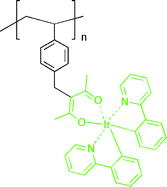A study on the preparation and photophysical properties of an iridium(iii) complexed homopolymer
Abstract
We have prepared a poly(styrene) [poly(Irppy2acac)] that has a bis(2-phenylpyridyl)iridium(III) acetylacetonate complex attached to every ‘monomer’ via a


 Please wait while we load your content...
Please wait while we load your content...